Ariston ARTXL 109 User Manual [ru, es, it, en, cs]

Instructions for use
GB |
|
|
ES |
|
CIS |
|
|
|
|
|
|
|
|
English,1 |
Español,13 |
РУССКИЙ, 25 |
||||
|
|
|
|
|
|
|
I |
|
|
GR |
|
CZ |
|
|
|
|
|
|
|
|
Italiano,37 |
ЕллзнйкЬ,49 |
Èesky,61 |
||||
ARTXL 109
WASHING MACHINE
Contents
GB
Installation, 2-3
Unpacking and levelling
Connecting the electricity and water supplies The first wash cycle
Technical data
Description of the washing machine and starting a wash cycle, 4-5
Control panel Indicator lights
How to open and shut the drum Starting a wash cycle
Wash cycles, 6
Table of wash cycles
Personalisation, 7
Setting the temperature
Setting the spin speed
Functions
Detergents and laundry, 8
Detergent dispenser drawer
Bleach cycle
Preparing the laundry
Garments requiring special care
Load balancing system
Precautions and tips, 9
General safety Disposal
Saving energy and respecting the environment
Care and maintenance, 10
Cutting off the water or electricity supply
Cleaning the washing machine
Caring for your appliance door and drum
Cleaning the pump
Checking the water inlet hose
How to clean the detergent dispenser
Troubleshooting, 11
Service, 12
1
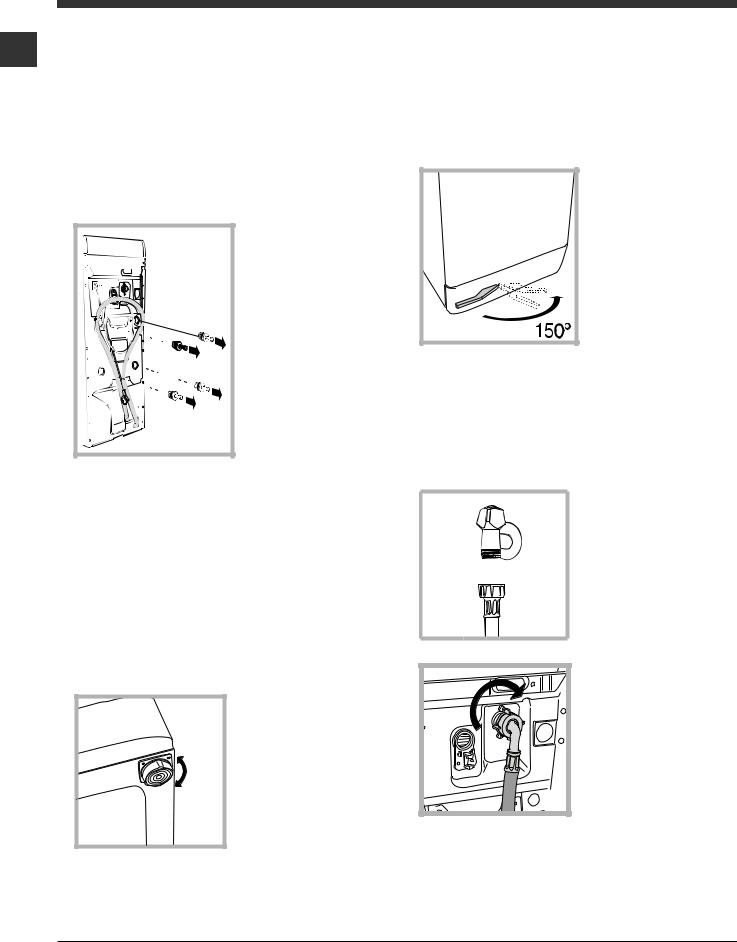
Installation
Keep this instruction manual in a safe place for GB future reference. Should the appliance be sold,
transferred or moved, make sure the instruction manual accompanies the washing machine to inform the new owner as to its operation and features.
Read these instructions carefully: they contain vital information on installation, use and safety.
Unpacking and levelling
Unpacking
1. Unpack the
washing machine.
2. Check whether the
washing machine has
been damaged during
transport. If this is the
case, do not install it
and contact your
retailer.
3. Remove the four protective screws and the rubber washer with the respective spacer, situated on the rear of the appliance (see figure).
4.Seal the gaps using the plastic plugs provided.
5.Keep all the parts: you will need them again if the washing machine needs to be moved to another location.
Warning: should the screws be re-used, make sure you fasten the shorter ones at the top.
Packaging materials are not children's toys.
Levelling
Your machine may make a considerable amount of noise if the two front feet have not been adjusted correctly.
1. Install the washing machine on a flat sturdy floor, without
resting it up against
walls, furniture cabinets or other.
2. If the floor is not perfectly level, compensate for any unevenness by tightening or loosening
the adjustable front feet (see figure); the angle of inclination, measured according to the worktop, must not exceed 2°.
Levelling your appliance correctly will provide it with stability and avoid any vibrations, noise and shifting during operation. If it is placed on a fitted or loose carpet, adjust the feet in such a way as to allow enough room for ventilation beneath the washing machine.
Putting your appliance in place and moving it.
If your washing machine is equipped with a special set of retractable wheels you can easy move it. To lower the wheels and thus move the
appliance effortlessly,
just pull the lever, situated on the left-
hand side beneath the base. Once the
appliance is in the required position, put the lever back in place. The washing machine is now firmly in place (see figure).
Electric and water connections
Connecting the water inlet hose
1. Connect the supply pipe by screwing it to a cold water tab using a ¾ gas threaded connection (see figure).
Before performing the connection, allow the water to run freely until it is perfectly clear.
2. Connect the other end of the water inlet hose to the washing machine, screwing it onto the appliance's cold water inlet, situated on the top right-hand side on the rear of the appliance (see figure).
3. Make sure there are no kinks or bends in the hose.
The water pressure at the tap must be within the values indicated in the Technical details table
(on the next page).
If the water inlet hose is not long enough, contact a specialist store or an authorised serviceman.
2
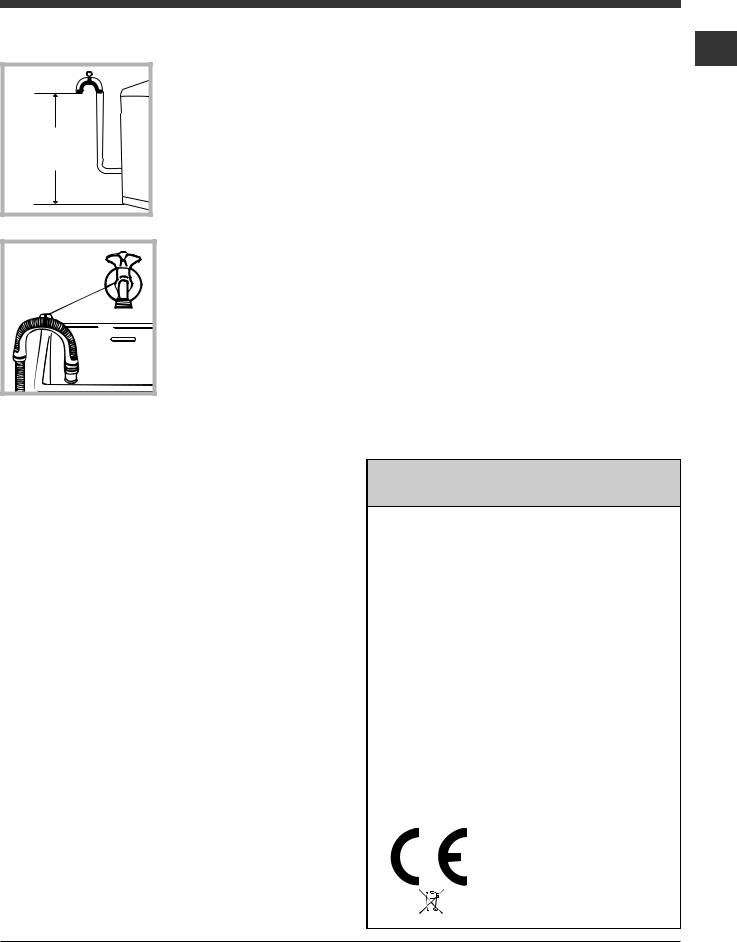
Connecting the drain hose
65 - 100 cm |
Connect the drain hose, without bending it, to a drainage duct or a wall drain located at a height between 65 and 100 cm from the floor;
alternatively, rest it on the side of a washbasin or bathtub, fastening the duct supplied to the tap (see figure). The free end of the hose should not be underwater.
We advise against the use of hose extensions; if it is absolutely necessary, the extension must have the same diameter as the original hose and must not exceed 150 cm in length.
Electrical connections
Before plugging the appliance into the electricity socket, make sure that:
•the socket is earthed and complies with all applicable laws;
•the socket is able to withstand the maximum power load of the appliance as indicated in the Technical data table (see opposite);
•the power supply voltage falls within the values indicated in the Technical data table (see opposite);
•the socket is compatible with the plug of the washing machine. If this is not the case, replace the socket or the plug.
The washing machine must not be installed outdoors, even in covered areas. It is extremely dangerous to leave the appliance exposed to rain, storms and other weather conditions.
When the washing machine has been installed, the electricity socket must be within easy reach.
Do not use extension cords or multiple sockets.
GB
The cable should not be bent or compressed.
The power supply cable must only be replaced by authorised technicians.
Warning! The company shall not be held responsible in the event that these regulations are not respected.
The first wash cycle
Once the appliance has been installed, and before you use it for the first time, run a wash cycle with detergent and no laundry, using the wash cycle 2.
Technical data
Model |
ARTXL 109 |
|||
|
|
|
|
|
|
|
|
width 40 cm |
|
Dimensions |
height 85 cm |
|||
|
|
|
depth 60 cm |
|
|
|
|
|
|
Capacity |
from 1 to 6 kg |
|||
|
|
|
|
|
Electrical |
please refer to the technical data |
|||
connections |
plate fixed to the machine |
|||
|
|
|
|
|
|
|
|
maximum pressure 1 MPa (10 bar) |
|
Water connections |
minimum pressure 0.05 MPa (0.5 bar) |
|||
|
|
|
drum capacity 42 litres |
|
|
|
|
|
|
Spin speed |
up to 1000 rotations per minute |
|||
|
|
|
|
|
Energy rated |
|
|||
programmes |
programme 7; temperature 60°C; |
|||
according to |
||||
using a load of 6 kg. |
||||
regulation |
||||
|
||||
EN 60456 |
|
|||
|
|
|
|
|
|
|
|
This appliance conforms to the |
|
|
|
|
following EC Directives: |
|
|
|
|
- 89/336/EEC dated 03/05/89 |
|
|
|
|
(Electromagnetic Compatibility) and |
|
|
|
|
subsequent modifications |
|
|
|
|
- 2002/96/EC |
|
|
|
|
- 2006/95/EC (Low Voltage) |
|
|
|
|
||
3
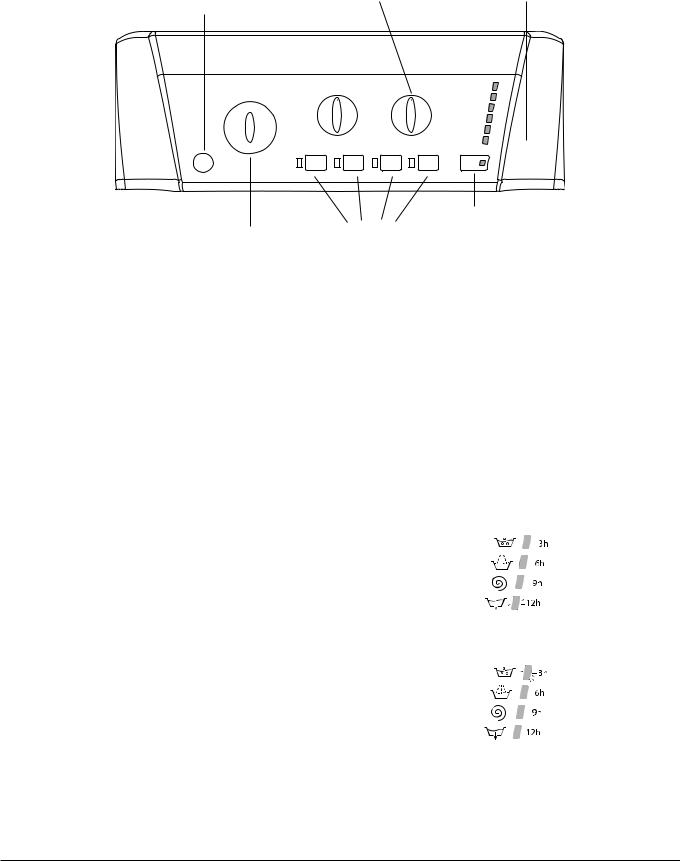
Description of the washing machine and starting a wash cycle
|
|
|
|
|
|
|
|
|
|
|
|
|
|
|
|
|
|
|
Control panel |
|
|
|
|
|
WASH CYCLE PROGRESS/ |
||||||||||
GB |
|
|
|
|
|
|
|
DELAY TIMER indicator lights |
|||||||||
|
|
|
|
SPIN SPEED |
|
|
|
|
|
|
|
||||||
|
|
|
|
|
|
|
|
|
|
||||||||
|
|
|
|
|
|
knob |
|
|
|
|
|
||||||
|
|
ON/OFF button |
TEMPERATURE |
|
|
|
|
|
|
|
|
|
|
|
LID LOCKED |
||
|
|
|
|
|
|
||||||||||||
|
|
|
|
|
|
|
|
|
|
|
|
|
indicator light |
||||
|
|
|
|
knob |
|
|
|
|
|
|
|
|
|
|
|
||
|
|
|
|
|
|
|
|
|
|
|
|
|
|
|
|
|
|
|
|
|
|
|
|
|
|
|
|
|
|
|
|
|
|
|
|
|
|
|
|
|
|
|
|
|
|
|
|
|
|
|
|
|
|
|
|
|
|
|
|
|
|
|
|
|
|
|
|
|
|
|
|
|
|
|
|
|
|
|
|
|
|
|
|
|
|
|
|
|
|
|
|
|
|
|
|
|
|
|
|
|
|
|
|
|
|
|
|
|
|
|
|
|
|
|
|
|
|
|
|
|
|
|
|
|
|
|
|
|
|
|
|
|
|
|
|
|
|
|
|
|
|
|
|
|
|
|
|
|
|
|
|
|
|
|
|
|
|
|
|
|
|
|
|
|
|
|
|
|
|
|
|
|
|
|
|
|
|
|
|
WASH CYCLE knob
ON/OFF button: switches the washing machine on and off.
WASH CYCLE knob: programmes the wash cycles. During the wash cycle, the knob does not move.
FUNCTION buttons with indicator light: used to select the available functions. The indicator light corresponding to the selected function will remain lit.
TEMPERATURE knob: sets the temperature or the cold wash cycle (see “Personalisation”).
SPIN SPEED knob: sets the spin speed or exclude the spin cycle completely (see “Personalisation”).
WASH CYCLE PROGRESS/DELAY TIMER indicator lights: used to monitor the progress of the wash cycle. The illuminated indicator light shows which phase is in progress. If the Delay Timer function has been set, the time remaining until the wash cycle starts will be indicated (see next page).
LID LOCKED indicator light: indicates whether the door may be opened or not (see next page).
START/PAUSE button with indicator light: starts or temporarily interrupts the wash cycles.
N.B. To pause the wash cycle in progress, press this button; the corresponding indicator light will flash orange, while the indicator light for the current wash cycle phase will remain lit in a fixed manner. If the LID LOCKED  indicator light is switched off, the door may be opened. To start the wash cycle from the point at which it was interrupted, press this button again.
indicator light is switched off, the door may be opened. To start the wash cycle from the point at which it was interrupted, press this button again.
START/PAUSE
button with indicator
FUNCTION light buttons with
indicator lights
Standby mode
This washing machine, in compliance with new energy saving regulations, is fitted with an automatic standby system which is enabled after about 30 minutes if no activity is detected. Press the ON-OFF button briefly and wait for the machine to start up again.
Indicator lights
The indicator lights provide important information. This is what they can tell you:
Delayed start
If the DELAY TIMER function has been activated (see “Personalisation”), after the wash cycle has been started the indicator light corresponding to the selected delay period will begin to flash:
As time passes, the remaining delay will be displayed and the corresponding indicator light will flash:
Once the set delay has elapsed, the flashing indicator light will switch off and the selected wash cycle will begin.
Wash cycle phase indicator lights
Once the desired wash cycle has been selected and has begun, the indicator lights switch on one by one to indicate which phase of the cycle is currently in progress.
4
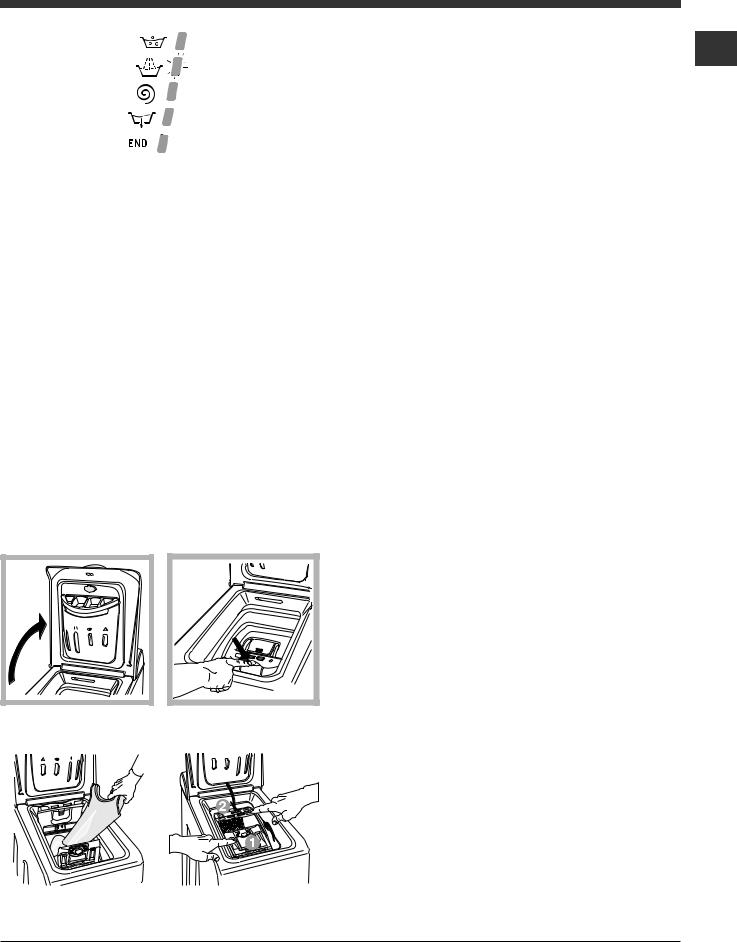
Wash
Rinse
Spin
Drain
End of wash cycle
Function buttons and corresponding indicator lights
When a function is selected, the corresponding indicator light will illuminate.
If the selected function is not compatible with the programmed wash cycle, the corresponding indicator light will flash and the function will not be activated. If a function which is incompatible with another function selected previously, only the most recent selection will remain active.
 Lid locked indicator light
Lid locked indicator light
If this indicator light is on, the appliance door is locked to prevent it from being opened accidentally; to avoid any damage, wait for the indicator light to switch off (it will take about three minutes) before you open the appliance door. N.B. If the DELAY TIMER function is activated, the door cannot be opened; pause the machine by pressing the START/PAUSE button if you wish to open it.
If the START/PAUSE indicator light (orange) flashes rapidly at the same time as the function indicator light, this indicates a problem has occurred (see “Troubleshooting”).
How to open and to close the drum
Fig. 1 |
|
Fig. 2 |
||||
|
|
|
|
|
|
|
|
|
|
|
|
|
|
|
|
|
|
|
|
|
Fig. 3 |
Fig. 4 |
A) Opening (Fig. 1):
Lift the external lid and open it completely. |
GB |
B)Opening the drum (Soft opening):
With one finger, push the button indicated in fig. 2 and the drum will open delicately.
C)Loading the washing machine (Fig. 3).
D)Shutting (Fig. 4):
-close the drum fully by first shutting the front door followed by the rear one;
-then ensure the hooks on the front door are perfectly housed within the seat of the rear door;
-after the hooks have clicked into position, press both doors lightly downwards to make sure they do not come loose;
-finally shut the external lid.
Starting a wash cycle
1.Turn the washing machine on by pressing the ON/OFF button. All the indicator lights will turn on for a few seconds, then only the indicator lights relative to the selected programme settings will remain lit and the START/PAUSE indicator light will flash.
2.Load the laundry, close the door and the lid.
3.Set the WASH CYCLE knob to the desired programme.
4.Set the washing temperature (see “Personalisation”).
5.Set the spin speed (see “Personalisation”).
6.Measure out the detergent and washing additives
(see “Detergents and laundry”).
7.Select the desired functions.
8.Start the wash cycle by pressing the START/ PAUSE button and the corresponding indicator light will remain lit in a fixed manner, in green.
To cancel the set wash cycle, pause the machine by pressing the START/PAUSE button and select a new cycle.
9.At the end of the wash cycle the 
 indicator light will switch on. The LID LOCKED indicator light will switch off, indicating that the door may be opened. Take out your laundry and leave the appliance door ajar to make sure the drum dries completely.
indicator light will switch on. The LID LOCKED indicator light will switch off, indicating that the door may be opened. Take out your laundry and leave the appliance door ajar to make sure the drum dries completely.
Switch the washing machine off by pressing the ON/ OFF button.
5

Wash cycles
Table of wash cycles
GB |
|
|
|
|
|
|
|
|
|
|
|
cycles |
|
Max. |
Max. |
Detergents |
Max. |
Cycle |
|||
|
|
|
||||||||
|
|
|
|
|
||||||
|
|
|
|
|
|
|
|
|||
|
|
Wash |
Description of the wash cycle |
temp. |
speed |
|
|
|
load |
duration |
|
|
|
|
Fabric |
||||||
|
|
|
(°C) |
(rpm) |
|
|
(kg) |
|||
|
|
|
Bleach |
Wash |
|
|||||
|
|
|
|
|
softener |
|
|
|||
|
|
|
|
|
|
|
|
|
|
|
|
|
|
Special cycles |
|
|
|
|
|
|
|
|
7 |
Sanitizing cycle 90°: Extremely soiled whites. |
90° |
1000 |
l |
l |
l |
6 |
165 |
|
|
|
|
|
|
|
|
|
|
|
|
|
7 |
Sanitizing cycle 90° (1): Heavily soiled whites and resistant colours. |
60° |
1000 |
- |
l |
l |
6 |
141 |
|
|
|
|
|
|
|
|
|
|
|
|
|
8 |
Goodnigt cycle: Lightly soiled delicate colours. |
40° |
800 |
- |
l |
l |
4 |
288 |
|
|
|
|
|
|
|
|
|
|
|
|
|
9 |
Baby cycle: Heavily soiled delicate colours. |
40° |
800 |
- |
l |
l |
2 |
116 |
|
|
|
|
|
|
|
|
|
|
|
|
|
10 |
Shirts |
40° |
600 |
- |
l |
l |
2 |
69 |
|
|
|
|
|
|
|
|
|
|
|
|
|
|
11 |
Silk/Curtains: For garments in silk and viscose, lingerie. |
30° |
0 |
- |
l |
l |
1 |
55 |
|
|
|
|
|
|
|
|
|
|
|
|
|
12 |
Wool: For wool, cashmere, etc. |
40° |
600 |
- |
l |
l |
1 |
55 |
|
|
|
|
|
|
|
|
|
|
|
|
|
|
Everyday wash cycles (Daily) |
|
|
|
|
|
|
|
|
1 |
Cotton + Prewash 90°: Extremely soiled whites. |
90° |
1000 |
- |
l |
l |
6 |
164 |
|
|
|
|
|
|
|
|
|
|
|
|
|
2 |
Cotton: Heavily soiled whites and resistant colours. |
60° |
1000 |
l |
l |
l |
6 |
138 |
|
|
|
|
|
|
|
|
|
|
|
|
|
2 |
Cotton (2): Heavily soiled whites and delicate colours. |
40° |
1000 |
l |
l |
l |
6 |
123 |
|
|
|
|
|
|
|
|
|
|
|
|
|
3 |
Coloured Cottons (3): Lightly soiled whites and delicate colours. |
40° |
1000 |
l |
l |
l |
6 |
89 |
|
|
|
|
|
|
|
|
|
|
|
|
|
4 |
Synthetics resistents: Heavily soiled resistant colours. |
60° |
800 |
- |
l |
l |
2,5 |
85 |
|
|
|
|
|
|
|
|
|
|
|
|
|
4 |
Synthetics delicates: Lightly soiled resistant colours. |
40° |
800 |
- |
l |
l |
2,5 |
73 |
|
|
|
|
|
|
|
|
|
|
|
|
|
|
5 |
Mix 30': To refresh lightly soiled garments quickly (not suitable for wool, |
30° |
800 |
- |
l |
l |
3 |
30 |
|
silk and clothes which require washing by hand). |
|||||||||
|
|
6 |
Mix 15': To refresh lightly soiled garments quickly (not suitable for wool, |
30° |
800 |
- |
l |
l |
1,5 |
15 |
|
silk and clothes which require washing by hand). |
|||||||||
|
|
|
Partials wash cycles |
|
|
|
|
|
|
|
|
|
|
Rinse |
- |
1000 |
l |
- |
l |
6 |
36 |
|
|
|
|
|
|
|
|
|
|
|
|
|
|
Spin |
- |
1000 |
- |
- |
- |
6 |
16 |
|
|
|
|
|
|
|
|
|
|
|
|
|
|
Light spin |
- |
800 |
- |
- |
- |
2,5 |
12 |
|
|
|
|
|
|
|
|
|
|
|
|
|
|
Drain no spin |
- |
0 |
- |
- |
- |
6 |
2 |
|
|
|
|
|
|
|
|
|
|
|
The information contained in the table is intended as a guide only.
For all Test Institutes:
1)Test wash cycle in compliance with regulation EN 60456: set wash cycle 7 with a temperature of 60°C.
2)Long wash cycle for cottons: set wash cycle 2 with a temperature of 40°C.
3)Short wash cycle for cottons: set wash cycle 3 with a temperature of 40°C.
Specials wash cycles
Sanitizing cycle (wash cycle 7). A high-temperature hygienic wash cycle (over 60°C) which requires the use of bleach. Pour the bleach, the detergent and the additives into the relevant compartments (see paragraph entitled
“Detergent dispenser drawer”).
Goodnigt cycle (wash cycle 8). This is a silent cycle which can be run at night, when the electricity prices are lower. The wash cycle is designed for cottons and synthetics. At the end of the cycle the machine stops while there is still water in the drum; to spin and drain the laundry press the START/PAUSE button; alternatively the machine will perform the spin cycle and drain the water automatically after 8 hours.
Baby cycle (wash cycle 9). This wash cycle can be used to remove the soiling typically caused by babies, while ensuring that all detergent is removed from nappies in order to prevent the delicate skin of babies from suffering allergies. The cycle has been designed to reduce the amount of bacteria by using a greater quantity of water and optimising the effect of special disinfecting additives added to the detergent.
Mix 30’ (wash cycle 5) this wash cycle was designed to wash lightly soiled garments quickly: it lasts just 30 minutes and therefore saves both energy and time. By selecting this wash cycle (5 at 30°C), it is possible to wash different fabrics together (except for wool and silk items), with a maximum load of 3 kg.
Mix 15’(wash cycle 6) this wash cycle was designed to wash lightly soiled garments quickly: it lasts just 15 minutes and therefore saves both energy and time. By selecting this wash cycle (6 at 30°C), it is possible to wash different fabrics together (except for wool and silk items), with a maximum load of 1.5 kg.
6

Personalisation
Setting the temperature
Turn the TEMPERATURE knob to set the wash temperature (see Table of wash cycles). |
GB |
|
|
The temperature may be lowered, or even set to a cold wash ( ). |
|
The washing machine will automatically prevent you from selecting a temperature which is higher than the |
|
maximum value set for each wash cycle. |
|
Setting the spin speed
Turn the SPIN SPEED knob to set the spin speed for the selected wash cycle.
The maximum spin speeds available for each wash cycle are as follows:
Wash cycles |
Maximum spin speed |
Cottons |
1000 rpm |
Synthetics |
800 rpm |
Wool |
600 rpm |
Silk |
drain only |
The spin speed may be lowered, or the spin cycle can be excluded altogether by selecting the symbol  . The washing machine will automatically prevent you from selecting a spin speed which is higher than the maximum speed set for each wash cycle.
. The washing machine will automatically prevent you from selecting a spin speed which is higher than the maximum speed set for each wash cycle.
Functions
The various wash functions available with this washing machine will help to achieve the desired results, every time. To activate the functions:
1.Press the button corresponding to the desired function;
2.the function is enabled when the corresponding indicator light is illuminated.
Note: If the indicator light flashes rapidly, this signals that this particular function may not be selected in conjunction with the selected wash cycle.
 Delay timer
Delay timer
This timer delays the start time of the wash cycle by up to 12 hours.
Press the button repeatedly until the indicator light corresponding to the desired delay time switches on. The fifth time the button is pressed, the function will be disabled.
N.B. Once you have pressed the START/PAUSE button, the delay time may only be decreased if you wish to modify it.
This option is enabled with all programmes.
 Easy iron
Easy iron
By selecting this function, the wash and spin cycles will be modified in order to reduce the formation of creases. At the end of the cycle the washing machine will perform slow rotations of the drum.
For the 11 wash cycle, the machine will end the cycle while the laundry is soaking, the EASY IRON and START/ PAUSE indicator lights will flash (orange) and the RINSE phase will remain lit in a fixed manner. To drain the water so that the laundry may be removed, press the START/PAUSE button or the EASY IRON button.
This function may not be used in conjunction with wash cycles 5, 6, 7, 8, 9, 12,  ,
,  ,
,  .
.
 Extra rinse
Extra rinse
By selecting this function, the efficiency of the rinse is increased and optimal detergent removal is guaranteed. It is particularly useful for sensitive skin.
This function may not be used in conjunction with wash cycles 5, 6,  ,
,  ,
,  .
.
 Super Wash
Super Wash
Because a greater quantity of water is used in the initial phase of the cycle, and because of the increased cycle duration, this function offers a high-performance wash.
This function may not be used in conjunction with wash cycles 5, 6, 7, 11, 12,  ,
,  ,
,  ,
,  .
.
7

Detergents and laundry
Detergent dispenser drawer
GB
Good washing results also depend on the correct dose of detergent: adding too much detergent won't necessarily make for a more efficient wash, and may in fact cause build up on the interior of your appliance and even pollute the environment.
Open up the detergent dispenser and pour in the detergent and fabric softener, as follows.
compartment 1: Detergent for pre-wash
compartment 2: Detergent for the wash cycle (powder or liquid)
It is recommended that you place liquid detergent directly into the compartment using the appropriate dosing cup.
compartment 3: Additives (softener, etc.)
When pouring the softener in compartment 3, avoid exceeding the "max" level indicated.
The softener is added automatically into the machine during the last wash. At the end of the wash programme, some water will be left in compartment 3. This is used for the inlet of denser fabric softeners into the machine, i.e. to dilute the more concentrated softeners. Should more than a normal amount of water remain in compartment 3, this means the emptying device is blocked. For cleaning instructions, see “Care and maintenance”.
compartment 4: Bleach
Preparing the laundry
•Divide the laundry according to:
-the type of fabric/the symbol on the label
-the colours: separate coloured garments from whites.
•Empty all garment pockets and check the buttons.
•Do not exceed the listed values, which refer to the weight of the laundry when dry:
Durable fabrics: max. 6 kg Synthetic fabrics: max. 2,5 kg Delicate fabrics: max. 2 kg Wool: max. 1 kg
How much does your laundry weigh?
1sheet 400-500 g
1pillow case 150-200 g
1tablecloth 400-500 g
1bathrobe 900-1200 g
1towel 150-250 g
Garments requiring special care
Shirts: use special wash cycle 10 to wash shirts in various fabrics and colours.
It guarantees maximum care is taken of the garments and minimises the formation of creases.
Silk: use special wash cycle 11 to wash all silk garments. We recommend the use of special detergent which has been designed to wash delicate clothes.
Curtains: fold curtains and place them in a pillow case or mesh bag. Use wash cycle 11.
Wool: is the only washing machine manufacturer to have been awarded the prestigious Woolmark Platinum Care endorsement (M.0508) by the Woolmark Company, which means that all woollen garments may be washed in the washing machine, even those which state “hand wash only”  on the label. Wash cycle 12 therefore offers complete peace of mind when washing woollen garments in the washing machine (max. load 1 kg) and guarantees optimal performance.
on the label. Wash cycle 12 therefore offers complete peace of mind when washing woollen garments in the washing machine (max. load 1 kg) and guarantees optimal performance.
Bleach cycle
Bleaching may only be performed in conjunction with wash cycles 2, 3, 7,  .
.
Pour the bleach into compartment 4; pour the detergent and softener into the corresponding compartments, then select one of the abovementioned wash cycles.
This option is recommended only for very soiled cotton garments.
Load balancing system
Before every spin cycle, to avoid excessive vibrations and to distribute the load in a uniform manner, the drum rotates continuously at a speed which is slightly greater than the washing rotation speed. If, after several attempts, the load is not balanced correctly, the machine spins at a reduced spin speed. If the load is excessively unbalanced, the washing machine performs the distribution process instead of spinning. To encourage improved load distribution and balance, we recommend small and large garments are mixed in the load.
8

Precautions and tips
This washing machine was designed and constructed in accordance with international safety regulations. The following information is provided for safety reasons and must therefore be read carefully.
General safety
•This appliance is not intended for use by persons (including children) with reduced physical, sensory or mental capabilities, or lack of experience and knowledge, unless they have been given supervision or instruction concerning use of the appliance by a person responsible for their safety. Children should be supervised to ensure that they do not play with the appliance.
•The washing machine must only be used by adults, in accordance with the instructions provided in this manual.
•This appliance was designed for domestic use only.
•Do not touch the machine when barefoot or with wet or damp hands or feet.
•Do not pull on the power supply cable when unplugging the appliance from the electricity socket. Hold the plug and pull.
•Do not touch the drained water as it may reach extremely high temperatures.
•Never force the porthole door. This could damage the safety lock mechanism designed to prevent accidental opening.
•If the appliance breaks down, do not under any circumstances access the internal mechanisms in an attempt to repair it yourself.
•Always keep children well away from the appliance while it is operating.
•If the appliance has to be moved, work in a group of two or three people and handle it with the utmost care. Never try to do this alone, because the appliance is very heavy.
•Before loading laundry into the washing machine, make sure the drum is empty.
Disposal
•Disposing of the packaging materials: observe local regulations so that the packaging may be re-used.
•The European Directive 2002/96/EC on Waste Electrical and Electronic Equipment, requires that old household electrical appliances must not be disposed of in the normal unsorted municipal waste stream. Old appliances must be collected separately in order to optimise the recovery and recycling of the materials they contain and reduce the impact on human health and the environment.
The crossed out "wheeled bin" symbol on the
product reminds you of your obligation, that when GB you dispose of the appliance it must be separately collected.
Consumers should contact their local authority or retailer for information concerning the correct disposal of their old appliance.
Saving energy and respecting the environment
Saving on detergent, water, energy and time
•To avoid wasting resources, the washing machine should be used with a full load. A full load instead of two half loads allows you to save up to 50% on energy.
•The pre-wash cycle is only necessary on extremely soiled garments. Avoiding it will save on detergent, time, water and between 5 and 15% energy.
•Treating stains with a stain remover or leaving them to soak before washing will cut down the need to wash them at high temperatures. A programme at 60°C instead of 90°C or one at 40°C instead of 60°C will save up to 50% on energy.
•Use the correct quantity of detergent depending on the water hardness, how soiled the garments are and the amount of laundry you have, to avoid wastage and to protect the environment: despite being biodegradable, detergents do contain ingredients that alter the natural balance of the environment. In addition, avoid using fabric softener as much as possible.
•If you use your washing machine from late in the afternoon until the early hours of the morning, you will help reduce the electricity board's peak load. The “Delay Timer” option helps to organise your wash cycles accordingly.
•If your laundry has to be dried in a tumble dryer, select a high spin speed. Having the least water possible in your laundry will save you time and energy in the drying process.
9

Care and maintenance
Cutting off the water or electricity GB supply
•Turn off the water tap after every wash. This will limit the wear of your appliance's water system and also prevent leaks.
•Unplug your appliance when cleaning it and during all maintenance operations.
Cleaning your appliance
The exterior and rubber parts of your appliance can be cleaned with a soft cloth soaked in lukewarm soapy water. Do not use solvents or abrasives.
Caring for your appliance door and drum
•Always leave the appliance door ajar to prevent unpleasant odours from forming.
Cleaning the pump
The washing machine is fitted with a self-cleaning pump that does not require any maintenance. Sometimes, small items (such as coins or buttons) may fall into the pre-chamber that protects the pump, situated in the lower part of the same.
Make sure the wash cycle has ended and unplug the appliance.
To recover any objects that have fallen into the prechamber:
1. remove the plinth at the bottom on the front side of the washing machine by pulling from the side with your hands (see figure);
2. unscrew the lid rotating it anticlockwise (see figure): a little water may trickle out. This is perfectly normal; 3. clean the interior thoroughly;
4. screw the lid back on;
5. reposition the panel, making sure the hooks are securely in place before you push it onto the appliance.
Checking the water inlet hose
Check the water inlet hose at least once a year. If you see any cracks, replace it immediately: during the wash cycles, water pressure is very strong and a cracked hose could easily split open.
Never use hoses that have already been used.
Disassembly:
Press lightly on the large button on the front of the detergent dispenser and pull it upwards (fig. 1, 2).
How to clean the detergent dispenser
Cleaning:
Then clean the dispenser under a tap (fig. 3) using an old toothbrush and, once the pair of siphons inserted in the top of compartments 1 and 2 (fig. 4) have been pulled out, check whether the same are not clogged and then rinse them.
Reassembly:
Do not forget to reinsert the pair of siphons into the special housings and then to replace the dispenser into its seat, clicking it into place
(fig. 4, 2 and 1).
Fig. 1 |
Fig. 2 |
Fig. 3 |
Fig. 4 |
|
|
|
|
10

Troubleshooting
Your washing machine could fail to work. Before contacting the Technical Assistance Centre (see “Assistance”),
make sure that the problem cannot be not solved easily using the following list. |
GB |
|
|
||
Problem: |
Possible causes / Solutions: |
|
The washing machine does not switch on.
The wash cycle does not start.
•The appliance is not plugged into the socket fully, or is not making contact.
•There is no power in the house.
•The appliance Lid is not shut properly.
•The ON/OFF button has not been pressed.
•The START/PAUSE button has not been pressed.
•The water tap has not been opened.
•A delayed start has been set (see “Personalisation”).
The washing machine does not take in water (the indicator light for the first wash cycle stage flashes rapidly).
•The water inlet hose is not connected to the tap.
•The hose is bent.
•The water tap has not been opened.
•There is no water supply in the house.
•The pressure is too low.
•The START/PAUSE button has not been pressed.
The washing machine continuously takes in and drains water.
•The drain hose is not fitted at a height between 65 and 100 cm from the floor (see “Installation”).
•The free end of the hose is under water (see “Installation”).
•The wall drainage system is not fitted with a breather pipe.
If the problem persists even after these checks, turn off the water tap, switch the appliance off and contact the Assistance Service. If the dwelling is on one of the upper floors of a building, there may be problems relating to water drainage, causing the washing machine to fill with water and drain continuously. Special anti-draining valves are available in shops and help to avoid this inconvenience.
The washing machine does not drain or spin.
•The wash cycle does not include draining: some wash cycles require the drain phase to be started manually.
•The EASY IRON function has been activated: To complete the wash cycle, press the START/PAUSE button (“Personalisation”).
•The drain hose is bent (see “Installation”).
•The drainage duct is clogged.
The washing machine vibrates a • The drum was not unlocked correctly during installation (see “Installation”). lot during the spin cycle. • The washing machine is not level (see “Installation”).
• The washing machine is trapped between cabinets and walls (see “Installation”).
The washing machine leaks. • The water inlet hose is not screwed on properly (see “Installation”).
•The detergent dispenser drawer is blocked (for cleaning instructions, see “Care and maintenance”).
•The drain hose is not fixed properly (see “Installation”).
The START/PAUSE indicator light (orange) and the function indicator lights flash rapidly.
There is too much foam.
•Switch off the machine and unplug it, wait for approximately 1 minute and then switch it back on again.
If the problem persists, contact the Technical Assistance Service.
•The detergent is not suitable for machine washing (it should display the text “for washing machines” or “hand and machine wash”, or the like).
•Too much detergent was used.
11

Service
Before calling for Assistance:
GB |
• Check whether you can solve the problem alone (see “Troubleshooting”); |
|
|
|
• Restart the programme to check whether the problem has been solved; |
|
• If this is not the case, contact an authorised Technical Assistance Centre using the telephone number |
|
provided on the guarantee certificate. |
|
Always request the assistance of authorised technicians. |
Have the following information to hand:
•the type of problem;
•the appliance model (Mod.);
•the serial number (S/N).
This information can be found on the data plate situated on the rear of the washing machine.
12

Manual de instrucciones
LAVADORA
Sumario
ES
|
|
Instalación, 14-15 |
ES |
|
|
|
Desembalaje y nivelación |
|
|
|
Conexiones hidráulicas y eléctricas |
|
|
|
Español |
Primer ciclo de lavado |
|
|
|
Datos técnicos |
ARTXL 109
Descripción de la lavadora y comienzo de un programa, 16-17
Panel de control Pilotos
Cómo abrir y cerrar el cesto Poner en marcha un programa
Programas, 18
Tabla de programas
Personalizaciones, 19
Seleccionar la temperatura
Seleccionar el centrifugado
Funciones
Detergentes y ropa, 20
Contenedor de detergentes
Ciclo de blanqueo
Preparar la ropa
Prendas especiales
Sistema de equilibrado de la carga
Precauciones y consejos, 21
Seguridad general
Eliminaciones
Ahorrar y respetar el ambiente
Mantenimiento y cuidados, 22
Interrumpir el agua y la corriente eléctrica Limpiar la lavadora
Cuidar la puerta y el cesto Limpiar la bomba
Controlar el tubo de alimentación de agua Cómo limpiar la cubeta de detergente
Anomalías y soluciones, 23
Asistencia, 24
13
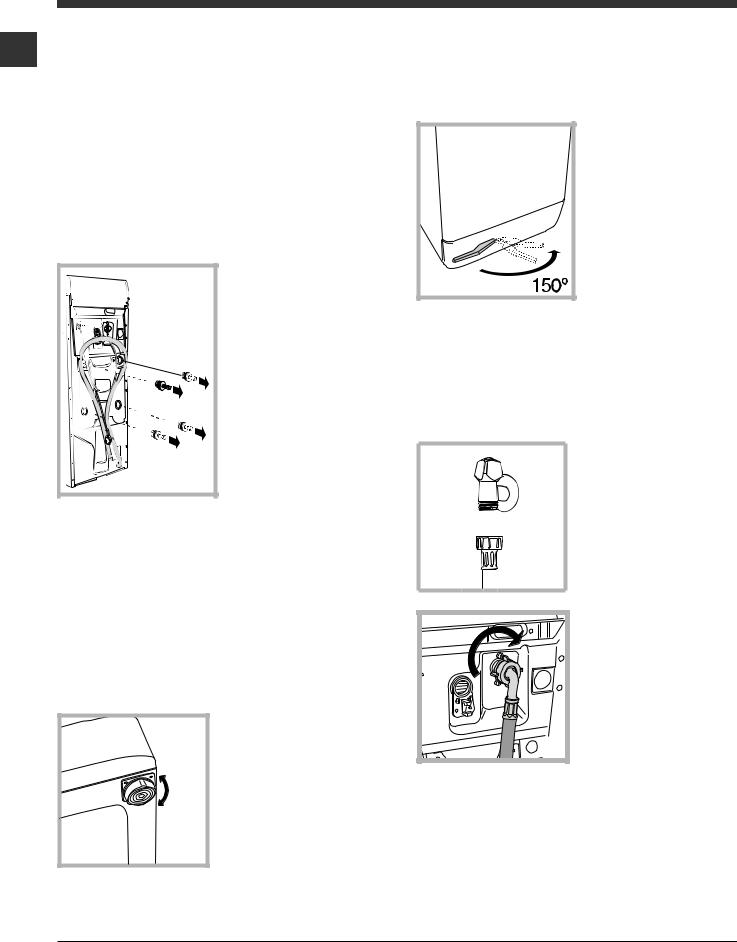
Instalación
Es importante conservar este manual para poder ES consultarlo en cualquier momento. En caso de venta,
de cesión o de traslado, verifique que permanezca junto con la lavadora para informar al nuevo propietario sobre el funcionamiento y brindar las correspondientes advertencias.
Lea atentamente las instrucciones: ellas contienen importante información sobre la instalación, el uso y la seguridad.
Desembalaje y nivelación
Desembalaje
1. Desembale la lavadora.
2. Controle que la lavadora no haya sufrido daños durante el transporte. Si estuviera dañada no la conecte y llame al revendedor.
3. Quite los cuatro tornillos de protección para el transporte y la arandela de goma con el correspondiente distanciador, ubicados en la parte posterior
(ver la figura).
4.Cierre los orificios con los tapones de plástico suministrados con el aparato.
5.Conserve todas las piezas: cuando la lavadora deba ser transportada nuevamente, deberán volver a colocarse. Atención: si vuelve a utilizar los tornillos más cortos, se deben colocar arriba.
Los embalajes no son juguetes para los niños.
Nivelación
1. Instale la lavadora sobre un piso plano y rígido, sin apoyarla en las paredes, muebles ni en ningún otro aparato.
2. Si el piso no está perfectamente horizontal, compense las irregularidades desenroscando o
enroscando los pies
delanteros (véase la figura); el ángulo de inclinación medido sobre la superficie de trabajo, no debe superar los 2º.
Una cuidadosa nivelación brinda estabilidad a la máquina y evita vibraciones, ruidos y desplazamientos durante el funcionamiento.
Cuando se instala sobre moquetas o alfombras, regule los pies para conservar debajo de la lavadora un espacio suficiente para la ventilación.
Instalación, desplazamientos
Si su lavadora està dotada de un carro especial con ruedas retráctiles, se facilitarà su desplazamiento. Para hacer descender este carro y poder
moverla sin esfuerzo, es
necesario tirar la
palanca, situada abajo a
la izquierda, debajo del zócalo. Finalizado el
desplazamiento es necesario devolverla a su posición inicial. A partir de ese momento, la máquina está sólidamente colocada.
Conexiones hidráulicas y eléctricas
Conexión del tubo de alimentación de agua
1. Introduzca la junta A en el extremo del tubo de alimentación y enrósquelo a un grifo de agua fría con boca roscada de 3/4
gas (ver la figura).
Antes de conectarlo, haga correr el agua hasta que esté límpida.
estrangulaciones. |
2. Conecte el tubo de alimentación a la lavadora enroscándolo en la toma de agua correspondiente ubicada en la parte posterior arriba y a la derecha (véase la
figura).
3. Verifique que el tubo no tenga pliegues ni
La presión de agua del grifo debe estar comprendida dentro de los valores contenidos en la tabla de Datos técnicos (ver la página del costado).
Si la longitud del tubo de alimentación no fuera suficiente, diríjase a una tienda especializada o a un técnico autorizado.
No utilice nunca tubos ya usados.
14
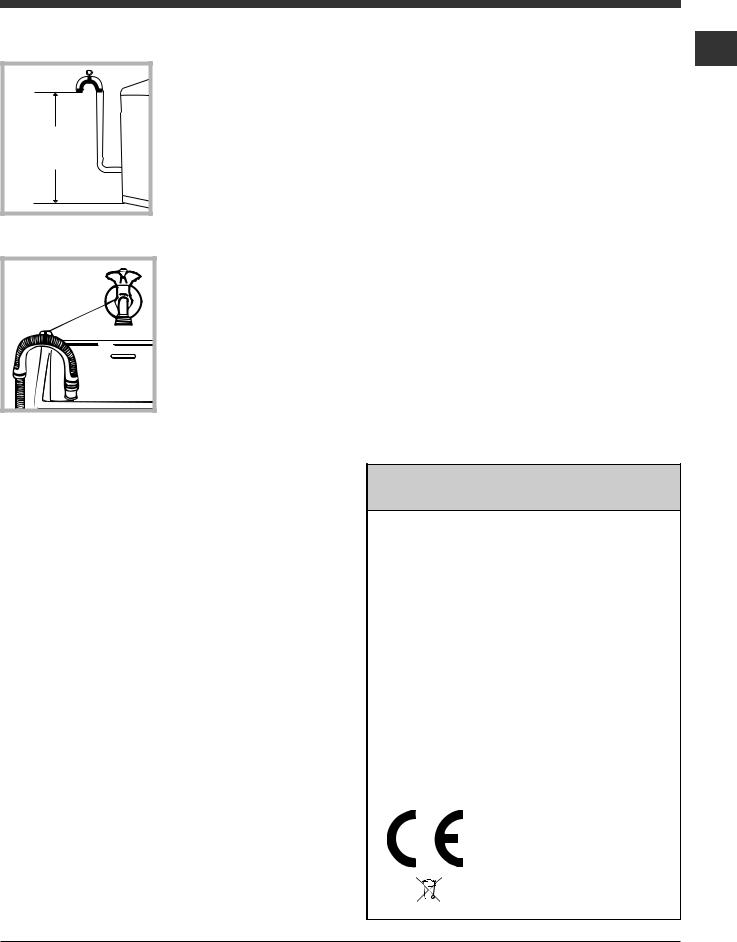
Conexión del tubo de descarga
65 - 100 cm |
Conecte el tubo de descarga, sin plegarlo, a una tubería de descarga o a una descarga de pared colocadas a una altura del piso entre 65 y 100 cm;
o apóyelo en el borde de un lavamanos o de una bañera, uniendo la guía suministrada con el aparato, al grifo (ver la figura). El extremo libre del tubo de descarga no debe permanecer sumergido en el agua.
No se aconseja utilizar tubos de prolongación, si fuera indispensable hacerlo, la prolongación debe tener el mismo diámetro del tubo original y no superar los 150 cm.
Conexión eléctrica
Antes de enchufar el aparato, verifique que:
•la toma tenga la conexión a tierra y haya sido hecha según las normas legales;
•la toma sea capaz de soportar la carga máxima de potencia de la máquina indicada en la tabla de Datos técnicos (ver al costado);
•la tensión de alimentación esté comprendida dentro de los valores indicados en la tabla de Datos técnicos (ver al costado);
•la toma sea compatible con el enchufe de la lavadora. Si no es así, sustituya la toma o el enchufe.
La lavadora no debe ser instalada al aire libre, ni siquiera si el lugar está reparado, ya que es muy peligroso dejarla expuesta a la lluvia o a las tormentas.
Una vez instalada la lavadora, la toma de corriente debe ser fácilmente accesible.
No utilice prolongaciones ni conexiones múltiples.
ES
El cable no debe estar plegado ni sufrir compresiones.
El cable de alimentación debe ser sustituido sólo por técnicos autorizados.
¡Atención! La empresa fabricante declina toda responsabilidad en caso de que estas normas no sean respetadas.
Primer ciclo de lavado
Después de la instalación y antes del uso, realice un ciclo de lavado con detergente y sin ropa, seleccionando el programa 2.
Datos técnicos
Modelo |
ARTXL 109 |
|||
|
|
|
|
|
|
|
|
ancho 40 cm. |
|
Dimensiones |
altura 85 cm. |
|||
|
|
|
profundidad 60 cm. |
|
|
|
|||
Capacidad |
de 1 a 6 kg. |
|||
|
|
|||
Conexiones |
ver la placa de características |
|||
eléctricas |
técnicas aplicada en la máquina |
|||
|
|
|
|
|
Conexiones |
presión máxima 1 MPa (10 bar) |
|||
presión mínima 0,05 MPa (0,5 bar) |
||||
hídricas |
||||
capacidad del cesto 42 litros |
||||
|
|
|
||
|
|
|||
Velocidad de |
máxima 1000 r.p.m. |
|||
centrifugado |
||||
|
||||
|
|
|||
Programas de |
programa 7; temperatura 60ºC; |
|||
control según la |
||||
efectuado con 6 kg. de carga. |
||||
norma EN 60456 |
||||
|
||||
|
|
|
|
|
|
|
|
Esta máquina cumple con lo |
|
|
|
|
establecido por las siguientes |
|
|
|
|
Directivas de la Comunidad: |
|
|
|
|
- 89/336/CEE del 03/05/89 |
|
|
|
|
(Compatibilidad Electromagnética) y |
|
|
|
|
sucesivas modificaciones |
|
|
|
|
- 2002/96/CE |
|
|
|
|
- 2006/95/CE (Baja Tensión) |
|
|
|
|
||
|
|
|
||
15
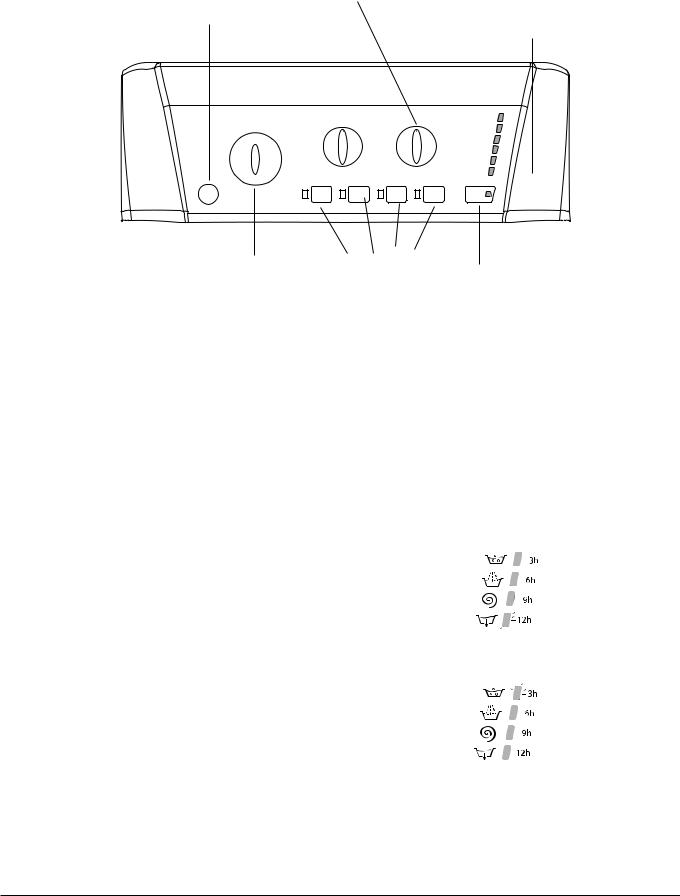
Descripción de la lavadora y comienzo de un programa
|
|
|
|
|
|
|
|
|
|
|
|
|
|
|
|
|
|
|
|
|
Panel de control |
|
|
|
Mando de |
|
|
|
|
|
|
|
|
|
|
||||
ES |
CENTRIFUGADO |
Pilotos DE AVANCE DEL |
|||||||||||||||||
|
|
||||||||||||||||||
|
|
|
|
|
|
|
|
||||||||||||
|
|
|
|
|
|
|
|
|
CICLO/COMIENZO |
||||||||||
|
|
Botón de |
|
|
|
|
|
|
RETRASADO |
||||||||||
|
|
ENCENDIDO/ |
Mando de |
|
|
|
|
|
|
|
|
|
|
Piloto PUERTA |
|||||
|
|
|
|
|
|
|
|
|
|
|
|
||||||||
|
|
APAGADO |
TEMPERATURA |
|
|
|
|
|
|
|
|
|
|
BLOQUEADA |
|||||
|
|
|
|
|
|
|
|
|
|
|
|
|
|
|
|
|
|
|
|
|
|
|
|
|
|
|
|
|
|
|
|
|
|
|
|
|
|
|
|
|
|
|
|
|
|
|
|
|
|
|
|
|
|
|
|
|
|
|
|
|
|
|
|
|
|
|
|
|
|
|
|
|
|
|
|
|
|
|
|
|
|
|
|
|
|
|
|
|
|
|
|
|
|
|
|
|
|
|
|
|
|
|
|
|
|
|
|
|
|
|
|
|
|
|
|
|
|
|
|
|
|
|
|
|
|
|
|
|
|
|
|
|
|
|
|
|
|
|
|
|
|
|
|
|
|
|
|
|
|
|
|
|
|
|
|
|
|
|
|
|
|
|
|
|
|
|
|
|
|
|
|
|
|
|
|
|
|
|
|
Mando de |
Botón con piloto |
PROGRAMAS |
PUESTA EN |
Botones con pilotos |
MARCHA/PAUSA |
FUNCIÓN |
|
Botón de ENCENDIDO/APAGADO: para encender y apagar la lavadora.
Mando de PROGRAMAS: para elegir los programas. Durante el funcionamiento del programa el mando no se mueve.
Botones con pilotos de FUNCIÓN: para seleccionar las funciones disponibles. El piloto correspondiente a la función seleccionada permanecerá encendido.
Mando de CENTRIFUGADO: para seleccionar el centrifugado o excluirlo (ver “Personalizaciones”).
Mando de TEMPERATURA: para seleccionar la temperatura o el lavado en frío (ver “Personalizaciones”).
Pilotos DE AVANCE DEL CICLO/COMIENZO RETRASADO: para seguir el estado de avance del programa de lavado. El piloto encendido indica la fase en curso. Si se seleccionó la función “Comienzo retrasado”, indicarán el tiempo que falta para la puesta en marcha del programa (ver la página correspondiente).
Piloto PUERTA BLOQUEADA: para saber si la puerta se puede abrir (ver la página correspondiente).
Botón con piloto PUESTA EN MARCHA/PAUSA: se utiliza para poner en marcha los programas o interrumpirlos momentáneamente.
Nota: Presione este botón para poner en pausa el lavado en curso, el piloto correspondiente centelleará con color anaranjado mientras que el de la fase en curso permanecerá encendido en forma fija. Si el piloto PUERTA BLOQUEADA  está apagado, se podrá abrir la puerta. Para que el lavado se reanude a partir del momento en el cual fue interrumpido, presione nuevamente este botón.
está apagado, se podrá abrir la puerta. Para que el lavado se reanude a partir del momento en el cual fue interrumpido, presione nuevamente este botón.
Modalidad de stand by
Esta lavasecadora está en conformidad con las nuevas normativas vinculadas al ahorro energético. Está dotada de un sistema de auto-apagado (stand by) que, en caso de no funcionamiento, se activa pasados aproximadamente 30 minutos. Presionar brevemente el botón ENCENDIDO/ APAGADO y esperar que la máquina se active.
Pilotos
Los pilotos suministran información importante. He aquí lo que nos dicen:
Comienzo retrasado
Si se ha activado la función “Comienzo retrasado” (ver “Personalizaciones”), después de haber puesto en marcha el programa, comenzará a centellear el piloto correspondiente al retraso seleccionado:
Con el transcurrir del tiempo se visualizará el retraso residual con el centelleo de la luz testigo correspondiente:
Una vez transcurrido el tiempo fijado, la luz testigo centelleante se apagará y comenzará el programa seleccionado.
Pilotos fase en curso
Una vez seleccionado y puesto en marcha el ciclo de lavado deseado, las luces testigo se encenderán progresivamente para indicar su estado de avance:
16
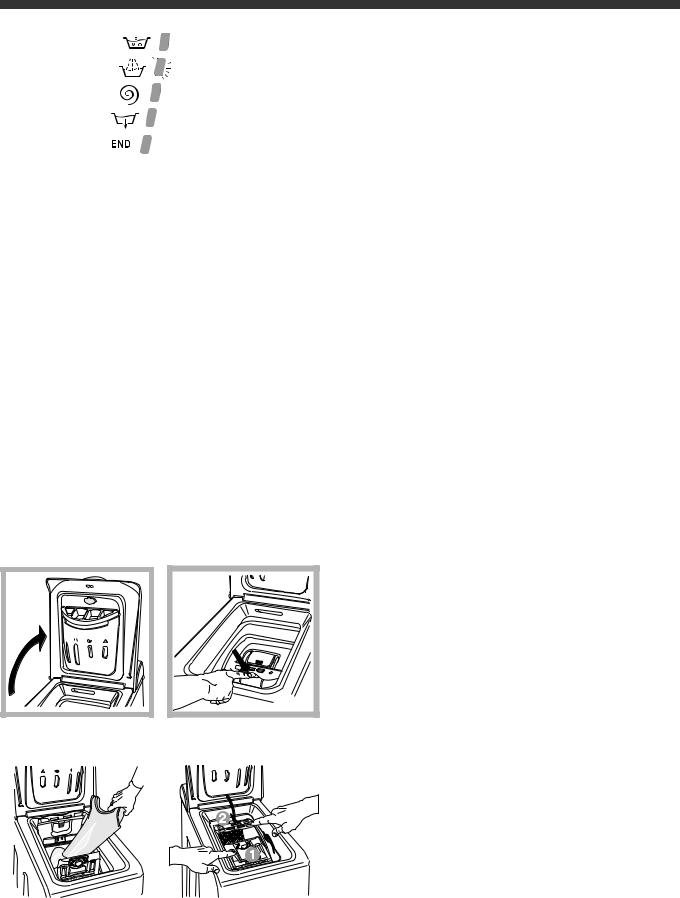
Lavado
Aclarado
Centrifugado
Descarga
Fin del Lavado
Botones de función y pilotos correspondientes
Seleccionando una función, el piloto correspondiente se iluminará. Si la función seleccionada no es compatible con el programa elegido, el piloto correspondiente centelleará y la función no se activará. Cuando se seleccione una función incompatible con otra seleccionada precedentemente, permanecerá activa sólo la última elección realizada.
 Piloto puerta bloqueada
Piloto puerta bloqueada
El piloto encendido indica que la puerta está bloqueada para impedir aperturas accidentales; antes de abrir la puerta es necesario esperar que dicho piloto se apague, de este modo se evitarán daños
(la espera es de aproximadamente 3 minutos). Nota: si la función “Comienzo retrasado” está activada, la puerta no se puede abrir, para abrirla se debe poner en pausa la máquina presionando el botón PUESTA EN MARCHA/PAUSA.
El centelleo rápido del piloto PUESTA EN MARCHA/ PAUSA (anaranjado) simultáneamente con el de las funciones indica una anomalía (ver “Anomalías y
soluciones”).
Cómo abrir y cerrar el cesto
Fig. 1 |
|
Fig. 2 |
||||
|
|
|
|
|
|
|
|
|
|
|
|
|
|
|
|
|
|
|
|
|
A) Abertura (Fig. 1): |
ES |
|
Levante la tapa externa y ábrala completamente. |
||
|
||
B) Abertura del cesto (Soft opening): |
|
|
|
||
Pulse el botón indicado en la fig. 2 con un dedo |
|
|
y el cesto se abrirá delicadamente. |
|
C)IntroduccIón de la ropa (Fig. 3).
D)Cierre (Fig. 4):
-cierre bien el cesto bajando primero la puerta delantera y apoyando luego la posterior;
-luego verifique que los ganchos de la puerta
delantera estén perfectamente alojados en la sede de la puerta posterior;
- después de haber escuchado el "clac" correspondiente al enganche, ejerza una leve presión hacia abajo sobre ambas puertas que no se deben desenganchar;
- por último cierre la tapa externa.
Poner en marcha un programa
1.Encienda la lavadora pulsando el botón ENCENDIDO/ APAGADO. Todos los pilotos se encenderán durante algunos segundos, luego permanecerán encendidos sólo los pilotos correspondientes a las configuraciones para el programa seleccionado y centelleará el piloto PUESTA EN MARCHA/PAUSA.
2.Cargue la ropa y cierre las puertas y la tapa.
3.Seleccione el programa deseado con el mando de PROGRAMAS.
4.Fije la temperatura de lavado (ver “Personalizaciones”).
5.Fije la velocidad de centrifugado (ver “Personalizaciones”).
6.Vierta detergente y aditivos (ver “Detergentes y ropa”).
7.Seleccione las funciones deseadas.
8.Ponga en marcha el programa presionando el botón PUESTA EN MARCHA/PAUSA y el piloto correspondiente permanecerá encendido, fijo y de color verde.
Para anular el ciclo seleccionado ponga en pausa la máquina presionando el botón PUESTA EN MARCHA/ PAUSA y elija un nuevo ciclo.
9.Al final del programa se iluminará el piloto 
 . El piloto PUERTA BLOQUEADA se apagará indicando que la puerta se puede abrir. Extraiga la ropa y deje la puerta semicerrada para permitir que el cesto se seque.Apague la lavadora presionando el botón ENCENDIDO/APAGADO.
. El piloto PUERTA BLOQUEADA se apagará indicando que la puerta se puede abrir. Extraiga la ropa y deje la puerta semicerrada para permitir que el cesto se seque.Apague la lavadora presionando el botón ENCENDIDO/APAGADO.
Fig. 3 |
Fig. 4 |
|
|
17
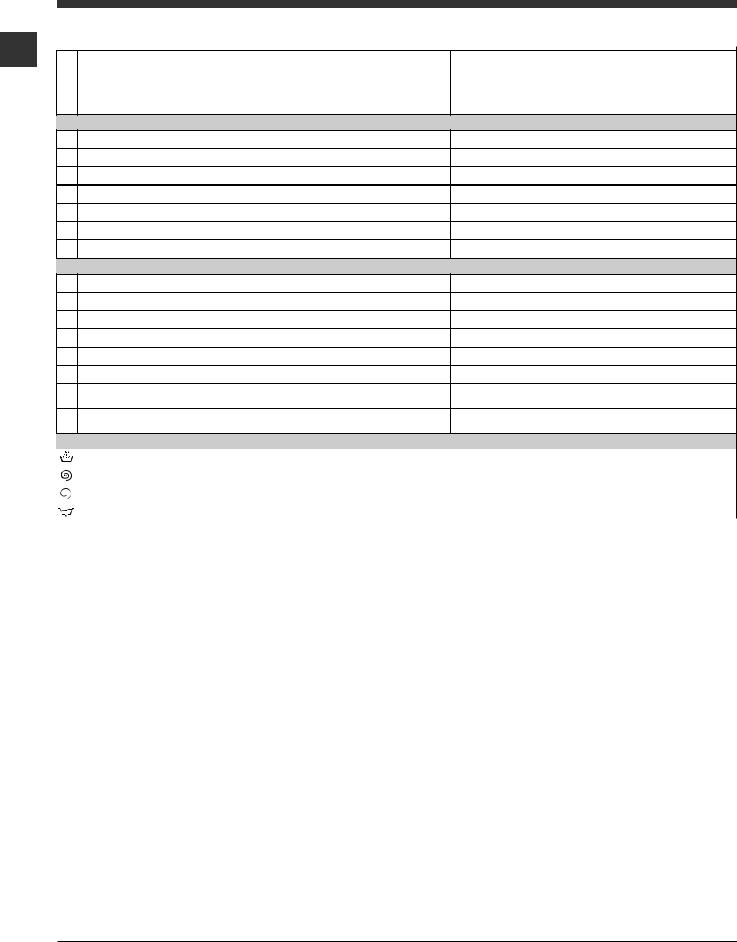
Programas
Tabla de programas
ES
Programas |
Descripción del Programa |
|
Programas Especiales
7Ciclo Desinfectante: ropa blanca muy sucia.
7Ciclo Desinfectante (1): blancos y colores resistentes muy sucios. 8 Ciclo Buenas Noches: colores delicados poco sucios.
9 Baby cycle: colores delicados muy sucios.
10Camisas
11Seda/Cortinas: para prendas de seda, viscosa, lencería.
12Lana: para lana, cachemira, etc.
Diario (programas para todos los días)
1 Prelavado Algodón 90°C: blancos sumamente sucios.
2Algodón: blancos y colores resistentes muy sucios.
2Algodón (2): blancos y colores delicados muy sucios.
3 Algodón de color (3): blancos poco sucios y colores delicados.
4Sintético: colores resistentes muy sucios.
4Sintético: colores resistentes poco sucios.
5Mix 30': para refrescar rápidamente prendas poco sucias (no se aconseja utilizarlo para lana, seda y prendas para lavar a mano).
6Mix 15': para refrescar rápidamente prendas poco sucias (no se aconseja utilizarlo para lana, seda y prendas para lavar a mano).
Programas Parciales
Temp. |
Velocidad |
Detergentes |
|
Carga |
|
|
||||
|
|
|
|
|
|
|
Duración |
|||
max. |
máx. |
|
|
|
|
|
|
máx. |
|
|
Blanqu- |
|
|
|
Suavi- |
|
|
del ciclo |
|||
(°C) |
(r.p.m.) |
|
|
|
|
(Kg.) |
|
|||
|
Lavado |
|
|
|
|
|||||
|
|
eador |
|
|
zante |
|
|
|
|
|
90° |
|
l |
|
l |
|
l |
|
6 |
|
165 |
|
|
|
|
|
||||||
1000 |
|
|
|
|
||||||
60° |
1000 |
- |
|
l |
|
l |
|
6 |
|
141 |
40° |
800 |
- |
|
l |
|
l |
|
4 |
|
288 |
40° |
800 |
- |
|
l |
|
l |
|
2 |
|
116 |
40° |
600 |
- |
|
l |
|
l |
|
2 |
|
69 |
30° |
0 |
- |
|
l |
|
l |
|
1 |
|
55 |
40° |
600 |
- |
|
l |
|
l |
|
1 |
|
55 |
90° |
|
- |
|
l |
|
l |
|
6 |
|
164 |
1000 |
|
|
|
|
||||||
60° |
1000 |
l |
|
l |
|
l |
|
6 |
|
138 |
40° |
1000 |
l |
|
l |
|
l |
|
6 |
|
123 |
40° |
1000 |
l |
|
l |
|
l |
|
6 |
|
89 |
60° |
800 |
- |
|
l |
|
l |
|
2,5 |
|
85 |
40° |
800 |
- |
|
l |
|
l |
|
2,5 |
|
73 |
30° |
800 |
- |
|
l |
|
l |
|
3 |
|
30 |
30° |
800 |
- |
|
l |
|
l |
|
1,5 |
|
15 |
|
|
|
|
|
|
|
|
|
|
|
|
Aclarado Algodón |
- |
1000 |
- |
- |
l |
6 |
36 |
|
|
|
|
|
|
|
|
|
|
Centrifugado Rápido |
- |
1000 |
- |
- |
- |
6 |
16 |
|
|
|
|
|
|
|
|
|
|
Centrifugado Delicado |
- |
800 |
- |
- |
- |
2,5 |
12 |
|
|
|
|
|
|
|
|
|
|
Descarga |
- |
0 |
- |
- |
- |
6 |
2 |
|
|
|
|
|
|
|
|
|
Los datos contenidos en la tabla tienen un valor indicativo.
Para todos los Test Institutes:
1)Programa de control según la norma EN 60456: seleccione el programa 7 con una temperatura de 60ºC.
2)Programa algodón largo: seleccione el programa 2 con una temperatura de 40ºC.
3)Programa algodón corto: seleccione el programa 3 con una temperatura de 40ºC.
Programas particulares
Ciclo Desinfectante (programa 7). Un programa higienizante con elevadas temperaturas, prevé el uso del blanqueador con temperaturas mayores que 60ºC. Para blanquear vierta el blanqueador, los detergentes y los aditivos en los compartimentos correspondientes (ver el párrafo “Contenedor de detergentes”).
Ciclo Buenas noches (programa 8). Es un ciclo silencioso que puede trabajar de noche cuando la tarifa energética es menor. El programa ha sido estudiado para prendas sintéticas y de algodón. Al final del ciclo, la máquina se detiene con el agua en la cuba; para realizar el centrifugado y la descarga presione el botón PUESTA EN MARCHA/PAUSA, de lo contrario, después de 8 horas, la máquina los realizará automáticamente.
Baby Cycle (programa 9). Programa capaz de eliminar la suciedad característica de los niños pero garantizando la eliminación del detergente de las prendas para evitar problemas de alergia en la piel delicada de los niños. El ciclo ha sido estudiado para disminuir la carga bacteriana utilizando una mayor cantidad de agua y optimizando el efecto de aditivos específicos higienizantes agregados al detergente.
Mix 30' (programa 5) fue estudiado para lavar prendas ligeramente sucias y en poco tiempo: dura sólo 30 minutos y de esa manera permite ahorrar energía y tiempo. Seleccionando el programa (5 a 30ºC) es posible lavar conjuntamente tejidos de distinto tipo (excluidas lana y seda), con una carga máxima de 3 kg.
Mix 15' (programa 6) fue estudiado para lavar prendas ligeramente sucias y en poco tiempo: dura sólo 15 minutos y de esa manera permite ahorrar energía y tiempo. Seleccionando el programa (6 a 30ºC) es posible lavar conjuntamente tejidos de distinto tipo (excluidas lana y seda), con una carga máxima de 1,5 kg.
18

Personalizaciones
|
|
|
|
Seleccionar la temperatura |
|
||
ES |
|||
Girando el mando de la TEMPERATURA se selecciona la temperatura de lavado (ver la Tabla de programas). |
|||
|
|||
La temperatura se puede disminuir hasta el lavado en frío ( ). |
|
||
|
|||
La máquina impedirá automáticamente seleccionar una temperatura mayor que la máxima prevista para cada |
|
||
programa. |
|
||
Seleccionar el centrifugado
Girando el mando de CENTRIFUGADO se selecciona la velocidad de centrifugado del programa seleccionado. Las velocidades máximas previstas para los programas son:
Programas |
Velocidad máxima |
|
Algodón |
1000 r.p.m. |
|
Sintéticos |
800 |
r.p.m. |
Lana |
600 |
r.p.m. |
Seda |
sólo descarga |
|
Se puede disminuir la velocidad de centrifugado o excluirlo seleccionando el símbolo  .
.
La máquina impedirá automáticamente efectuar un centrifugado a una velocidad mayor que la máxima prevista para cada programa.
Funciones
Las distintas funciones de lavado previstas por la lavadora permiten obtener la limpieza y el blanco deseados. Para activar las funciones:
1.presione el botón correspondiente a la función deseada;
2.el encendido del piloto correspondiente indica que la función está activa.
Nota: El centelleo rápido del piloto indica que la función correspondiente no se puede seleccionar para el programa elegido.
 Comienzo retrasado
Comienzo retrasado
Retrasa la puesta en marcha de la máquina hasta 12 horas.
Presione varias veces el botón hasta hacer encender la luz testigo correspondiente al retraso deseado. La quinta vez que se presione el botón, la función se desactivará.
Nota: Una vez presionado el botón PUESTA EN MARCHA/PAUSA, se puede modificar el valor del retraso sólo disminuyéndolo.
Se puede utilizar en todos los programas.
 Plancha fácil
Plancha fácil
Cuando se selecciona esta función, el lavado y el centrifugado se modificarán oportunamente para disminuir la formación de arrugas.
En el programa 11 la máquina terminará el ciclo dejando la ropa en remojo y el piloto de la función PLANCHA FÁCIL y el de PUESTA EN MARCHA/PAUSA centellearán (anaranjado) y el de la fase ACLARADO permanecerá encendido en forma fija. Para descargar el agua y poder sacar la ropa, es necesario presionar el botón PUESTA EN MARCHA/PAUSA o el botón PLANCHA FÁCIL.
No se puede activar con los programas 5, 6, 7, 8, 9, 12,  ,
,  ,
,  .
.
 Aclarado extra
Aclarado extra
Al elegir esta función aumentará la eficacia del aclarado y se asegurará la máxima eliminación del detergente. Es útil para pieles particularmente sensibles.
No se puede activar con los programas 5, 6,  ,
,  ,
,  .
.
 Super wash
Super wash
Gracias al uso de una mayor cantidad de agua en la fase inicial del ciclo y al empleo de mayor tiempo, dicha función garantiza un lavado con óptimos resultados.
No se puede activar con los programas 5, 6, 7, 11, 12,  ,
,  ,
,  ,
,  .
.
19

Detergentes y ropa
Cajón de detergentes
ES
El buen resultado del lavado depende también de la correcta dosificación del detergente: si se excede la cantidad, no se lava de manera más eficaz, sino que se contribuye a encostrar las partes internas de la lavadora y a contaminar el ambiente.
Extraiga el cajón de detergentes e introduzca el detergente o el aditivo de la siguiente manera:
cubeta 1: Detergente para prelavado (en polvo)
Preparar la ropa
•Subdivida la ropa según:
-el tipo de tejido / el símbolo en la etiqueta.
-los colores: separe las prendas de color y las blancas.
•Vacíe los bolsillos y controle los botones.
•No supere los valores indicados, referidos al peso de la ropa seca:
Tejidos resistentes: max 6 kg. Tejidos sintéticos: max 2,5 kg. Tejidos delicados: max 2 kg.
Lana: max 1 kg.
¿Cuánto pesa la ropa?
1 sábana 400/500 g
1 funda 150/200 g
1 mantel 400/500 g
1 albornoz 900/1200 g
1 toalla 150/250 g
cubeta 2: Detergente para lavado (en polvo o líquido)
El detergente líquido es conveniente colocarlo directamente en la cuba utilizando la correspondiente bola de dosificación.
cubeta 3: Aditivos (suavizante, etc.)
Cuando vierta el suavizante en el compartimiento 3, tenga cuidado de no superar el nivel "max" indicado. El suavizante se introduce automáticamente
en la máquina durante el último aclarado. Al finalizar el programa de lavado, en el compartimiento 3 permanece una cantidad residual de agua. La función de la misma es la introducción de suavizantes muy densos o diluir a aquellos concentrados. Si en el compartimiento 3 permaneciera más agua de la normal, esto significa que el dispositivo de vaciado está obstruido. Para la limpieza, véase
“Mantenimiento y cuidados”.
cubeta 4: Blanqueador
Prendas especiales
Camisas: para lavar camisas de distintos tipos de telas y color, utilice el programa 10. Garantiza su máximo cuidado minimizando la formación de arrugas.
Seda: utilice el programa correspondiente 11 para lavar todas las prendas de seda. Se aconseja el uso de un detergente específico para prendas delicadas. Cortinas: pliéguelas y colóquelas dentro de una funda o de una bolsa de red. Utilice el programa 11. Lana: es la única lavadora que ha obtenido el prestigioso reconocimiento Woolmark Platinum Care (M.0508) otorgado por The Woolmark Company que certifica el lavado en lavadora de todas las prendas de lana, incluidas aquellas que contienen la etiqueta “sólo lavado a mano”  . En consecuencia, con el programa 12 se puede utilizar la lavadora con total tranquilidad para lavar todas sus prendas de lana (máx. 1 kg) garantizando la obtención de los mejores resultados.
. En consecuencia, con el programa 12 se puede utilizar la lavadora con total tranquilidad para lavar todas sus prendas de lana (máx. 1 kg) garantizando la obtención de los mejores resultados.
Ciclo de blanqueo
El blanqueo se puede realizar sólo con los programas
2, 3, 7,  .
.
Vierta el blanqueador en la cubeta 4, el detergente y el suavizante en las correspondientes cubetas y luego seleccione uno de los programas indicados.
Es adecuado sólo para prendas de algodón muy sucias.
Sistema de equilibrado de la carga
Antes de cada centrifugado, para evitar vibraciones excesivas y para distribuir la carga de modo uniforme, el cesto realiza rotaciones a una velocidad ligeramente superior a la del lavado. Si después de varios intentos, la carga todavía no está correctamente equilibrada, la máquina realiza el centrifugado a una velocidad inferior a la prevista. Cuando existe un excesivo desequilibrio, la lavadora realiza la distribución antes que el centrifugado. Para obtener una mejor distribución de la carga y su correcto equilibrado, se aconseja mezclar prendas grandes y pequeñas.
20

Precauciones y consejos
La lavadora fue proyectada y fabricada en conformidad con las normas internacionales de seguridad. Estas advertencias se suministran por razones de seguridad y deben ser leídas atentamente.
Seguridad general
•El aparato no debe ser empleado por personas (niños incluidos) con capacidades físicas, sensoriales o mentales reducidas y con experiencias y conocimientos insuficientes, a menos que dicho uso no se realice bajo la supervisión o las instrucciones de una persona responsable de su seguridad. Los niños deben ser vigilados para asegurarse que no jueguen con el aparato.
•La lavadora debe ser utilizada sólo por personas adultas y siguiendo las instrucciones contenidas en este manual.
•Este aparato ha sido fabricado para un uso de tipo doméstico exclusivamente.
•No toque la máquina con los pies desnudos ni con las manos o los pies mojados o húmedos.
•No desenchufe la máquina tirando el cable, sino tomando el enchufe.
•No toque el agua de descarga porque puede alcanzar temperaturas elevadas.
•En ningún caso fuerce la puerta: podría dañarse el mecanismo de seguridad que la protege de aperturas accidentales.
•En caso de avería, no acceda nunca a los mecanismos internos para intentar una reparación.
•Controle siempre que los niños no se acerquen a la máquina cuando está en funcionamiento.
•Si debe ser trasladada, deberán intervenir dos o más personas, procediendo con el máximo cuidado. La máquina no debe ser desplazada nunca por una sola persona ya que es muy pesada.
•Antes de introducir la ropa controle que el cesto esté vacío.
Eliminaciones
•Eliminación del material de embalaje: respete las normas locales, de ese modo, los embalajes podrán volver a ser utilizados.
•En base a la Norma europea 2002/96/CE de Residuos de aparatos Eléctricos y Electrónicos, los electrodomésticos viejos no pueden ser arrojados en los contenedores municipales habituales; tienen que ser recogidos selectivamente para optimizar la recuperación y reciclado de los componentes y materiales que los constituyen, y reducir el impacto en la salud humana y el medioambiente.
El símbolo del cubo de basura tachado se marca |
ES |
|
sobre todos los productos para recordar al |
||
|
||
consumidor la obligación de separarlos para la |
|
|
|
||
recogida selectiva. |
|
|
El consumidor debe contactar con la autoridad |
|
|
local o con el vendedor para informarse en relación |
|
|
a la correcta eleminación de su electrodoméstico |
|
|
viejo. |
|
Ahorrar y respetar el medio ambiente
Tecnología a servicio del medio ambiente: ahorrar detergente, agua, energía y tiempo
•Para no derrochar recursos es necesario utilizar la lavadora con la máxima carga. Una carga completa en lugar de dos medias cargas permite ahorrar hasta el 50% de energía.
•El prelavado es necesario sólo para ropa muy sucia. Evitarlo permite ahorrar detergente, tiempo, agua y entre el 5 y el 15% de energía.
•Tratar las manchas con un quitamanchas o dejarlas en remojo antes del lavado, disminuye la necesidad de lavar a altas temperaturas. Un programa a 60ºC en vez de 90ºC o uno a 40ºC en vez de 60ºC, permite ahorrar hasta un 50% de energía.
•Dosificar bien el detergente en base a la dureza del agua, al grado de suciedad y a la cantidad de ropa evita derroches y protege el ambiente: aún siendo biodegradables, los detergentes contienen elementos que alteran el equilibrio de la naturaleza. Además, si es posible, evite utilizar el suavizante.
•Realizando los lavados desde el atardecer hasta las primeras horas de la mañana se colabora para reducir la carga de absorción de las empresas eléctricas.
La opción “Comienzo retrasado” ayuda mucho a organizar los lavados en ese sentido.
•Si el lavado debe ser secado en una secadora, seleccione una velocidad de centrifugado alta. Poca agua en el lavado, permite ahorrar tiempo y energía en el programa de secado.
21
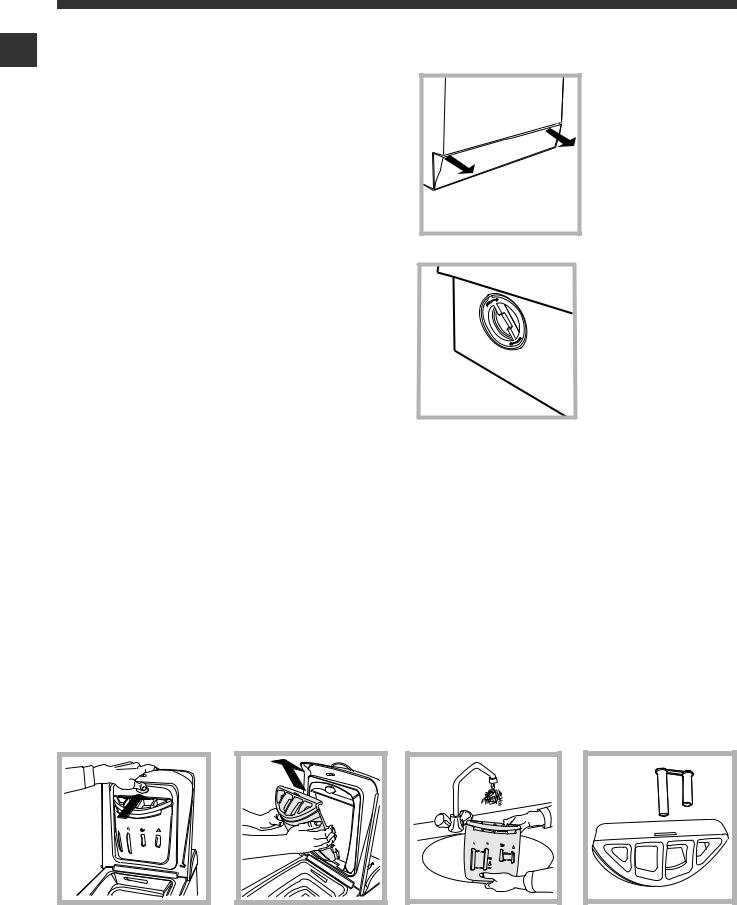
Mantenimiento y cuidados
Excluir agua y corriente eléctrica
ES
• Cierre el grifo de agua después de cada lavado. De este modo se limita el desgaste de la instalación hidráulica de la lavadora y se elimina el peligro de pérdidas.
• Desenchufe la máquina cuando la deba limpiar y durante los trabajos de mantenimiento.
Limpiar la lavadora
La parte externa y las partes de goma se pueden limpiar con un paño embebido en agua tibia y jabón. No use solventes ni productos abrasivos.
Cuidar la puerta y el cesto
•Deje siempre semicerrada la puerta para evitar que se formen malos olores.
Limpiar la bomba
La lavadora posee una bomba autolimpiante que no necesita mantenimiento. Pero puede suceder que objetos pequeños (monedas, botones) caigan en la precámara que protege la bomba, situada en la parte inferior de la misma.
Verifique que el ciclo de lavado haya terminado y desenchufe la máquina.
Para recuperar los objetos caídos en la precámara:
1. quite el zócalo
ubicado en la parte
inferior delantera de la
lavadora tirando de los costados con las manos (ver la figura);
2. desenrosque la tapa girándola en sentido antihorario (ver la figura); es normal que se vuelque un poco de agua;
3. limpie con cuidado el
interior;
4. vuelva a enroscar la tapa;
5. vuelva a montar el panel verificando, antes de empujarlo hacia la máquina, que los ganchos se hayan
introducido en las correspondientes ranuras.
Controle el tubo de alimentación de agua
Controle el tubo de alimentación al menos una vez al año. Si presenta grietas o rozaduras se debe sustituir: durante los lavados, las fuertes presiones podrían provocar roturas imprevistas.
No utilice nunca tubos ya usados.
Desmontaje:
Ejerza una ligera presión sobre el botón grande en la parte delantera de la cubeta de detergente y tírelo hacia arriba (fig. 1, 2).
Cómo limpiar la cubeta de detergente
Limpieza:
Limpie luego la cubeta bajo el grifo (fig. 3) utilizando un viejo cepillo de dientes y, una vez extraído el par de sifones ubicados en la parte superior de los compartimientos 1 y 2 (fig. 4), controle que los mismos no estén obstruidos y enjuáguelos.
Reinstalación:
No olvide volver a introducir el par de sifones en sus correspondientes alojamientos y por último volver a colocar la cubeta en su lugar, enganchándola (fig. 4, 2, 1).
Fig. 1 |
Fig. 2 |
Fig. 3 |
Fig. 4 |
|
|
|
|
22
